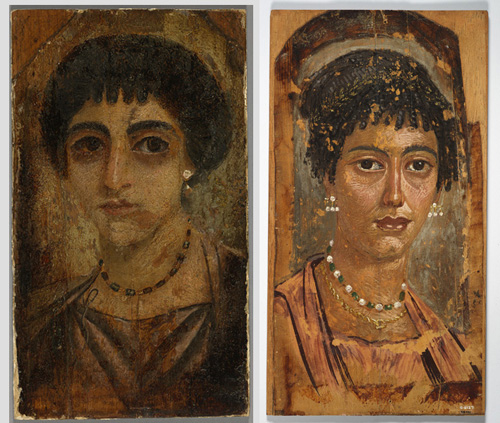TORONTO, February 28, 2019— After more than 100 years of separation, the Royal Ontario Museum (ROM) is reuniting two extraordinarily well-preserved Fayum mummy portraits. The paintings will both be on display at the ROM starting May 18, 2019, in the Museum’s Eaton Gallery of Rome. Charles T. Currelly, one of the ROM’s founders, obtained the two mummy portraits from Sotheby’s in 1912. After acquiring the two portraits, one of them remained at the ROM, while the other went to the National Gallery of Canada.
“To have this pair of Fayum portraits reunited is exciting for the Museum and for our visitors,” says Josh Basseches, ROM Director & CEO. “Together, these luminous works speak to us across time and provide a rare glimpse into the evocative and enduring traditions of ancient Egyptian society during the Roman era. The addition of this portrait to our outstanding Eaton Gallery has been well worth the wait.”
 Romano-Egyptian Fayum mummy portraits, which originally covered the face of mummies, hold great significance since they represent some of the earliest known and finest painted portraits in the history of art. Some are wonderfully preserved, and they are an unmatched source of information on Egyptian, Greek and Roman cultural traditions. These striking portraits bring to life the men, women and children who once lived in Roman Egypt over 1,700 years ago.
Romano-Egyptian Fayum mummy portraits, which originally covered the face of mummies, hold great significance since they represent some of the earliest known and finest painted portraits in the history of art. Some are wonderfully preserved, and they are an unmatched source of information on Egyptian, Greek and Roman cultural traditions. These striking portraits bring to life the men, women and children who once lived in Roman Egypt over 1,700 years ago.
After Charles T. Currelly, the Royal Ontario Museum of Archaeology’s first Director, acquired the two portraits at auction in London, he sold one of them to the National Gallery of Canada later that year. And now, a century later, thanks to the generosity of the Mona Campbell Endowment Fund and the Louise Hawley Stone Charitable Trust, the two portraits are back together again.
“Today, about a thousand Fayum portraits have survived to the present, but sadly many are damaged and incomplete,” says Paul Denis, Assistant Curator, (Greek, Etruscan, Roman & Byzantine). “These beautiful portraits, that Charles Currelly once held, literally put a face to the ROM’s Romano-Egyptian artifacts.”
Egypt became a Roman province in 30 BC after Mark Antony and Cleopatra, the Queen of Egypt, were defeated at the Battle of Actium by the future first Roman Emperor, Augustus. Many Romans began to settle in Egypt and adopted local funeral rites, such as embalming. They also introduced a new custom of attaching painted portraits to mummified remains.
Mummy portraits replaced the traditional three-dimensional masks and also enabled identification of the deceased. These paintings, created with wax or tempera on wood panels or canvas shrouds, were made during the Roman era, from about AD 20 to AD 300.
The name “Fayum mummy portraits” originates from the region they were first discovered, though other portraits have been found elsewhere in Egypt, especially at Saqqara, Thebes, Antinopolis and Akhmim. No other region of the Roman Empire has preserved such a large number of portrait paintings.
This type of portrait was unknown until 1887, when farmers discovered many of them at er-Rubayat, in the Fayum region. Theodor von Graf, a Viennese antiquarian, bought the paintings and through a series of exhibitions in Berlin, Munich, Paris, Brussels, London, and New York, made them widely known to the public at the time. In 1888, Sir Flinders Petrie, a British archaeologist and Egyptologist, discovered a further 81 mummy portraits at Hawara, an ancient Roman cemetery also located in the Fayum area. This pair of Fayum portraits were both found by Petrie but at different sites, one from Hawara and the other from a burial site elsewhere in the Fayum.
This pair of paintings will go on display in the Eaton Gallery of Rome starting May 18, 2019.
ROM Connects lecture:
Faces for Eternity: Romano-Egyptian Mummy Portraits at the ROM
May 18, 2019
Celebrate International Museum Day on Satuday, May 18, 2019, with Paul Denis, Assistant Curator (Greek, Etruscan, Roman & Byzantine), who will place the ROM's mummy portraits in their historical context, trace the portraits’ long journey from the Fayum region of Egypt to Toronto, with a few extra stops along the way. Paul will unravel the twisted path that these two unique objects have taken, from discovery and purchase to being separated and finally reunited at the ROM. Program webpage link.
-30-
ROM MEDIA CONTACT
David McKay, Communications Coordinator
davidm@rom.on.ca
ROM SOCIAL MEDIA
Instagram: @romtoronto
Facebook: @royalontariomuseum
Twitter: @ROMtoronto
